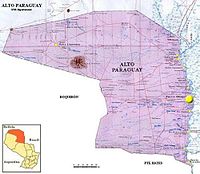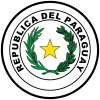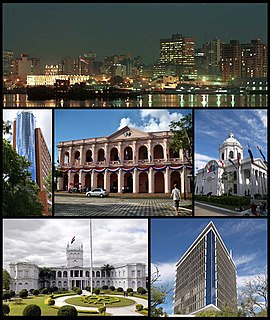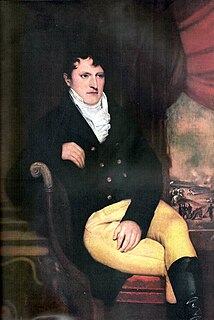
Concepción is a department of Paraguay. The capital is the city of Concepción.

Presidente Hayes is a department in Paraguay. The capital is the city of Villa Hayes. The department was named after U.S. President Rutherford B. Hayes, who awarded the territory to Paraguay while arbitrating a boundary dispute between Paraguay and Argentina after the Paraguayan War.

Roque González de Santa Cruz, S.J., was a Jesuit priest who was the first missionary among the Guarani people in Paraguay. He is honored as a martyr and saint by the Catholic Church.

Fuerte Olimpo is a city in Paraguay. It is the capital of the department of Alto Paraguay. Straddling the river Paraguay which forms the border with Brazil, Fuerte Olimpo is Paraguay's northernmost departmental capital, located over 830 km (515 mi) north of the capital Asunción. It was originally called Fuerte Borbón. The city is also known as “la puerta de entrada al Pantanal”, or entrance to the Pantanal region.

Pilar is the capital city of the Paraguayan department of Ñeembucú, located along the Paraguay River in the southwestern part of the country. Located about 358 km (222 mi) from Asunción, Pilar serves as an important center of commerce and government for the far southwestern region of the country.

Guaycuru or Guaykuru is a generic term for several ethnic groups indigenous to the Gran Chaco region of South America, speaking related Guaicuruan languages. In the 16th century, the time of first contact with Spanish explorers and colonists, the Guaycuru people lived in the present-day countries of Argentina, Paraguay, Bolivia, and Brazil.

Pedro Juan Caballero was a leading figure of Paraguayan independence. He was born in Tobatí, a town located Cordillera Department of Paraguay which was then part of the Spanish Viceroyalty of the Río de la Plata. He was one of the major leaders of the Revolution of May 14, 1811, despite being six years younger than the leading figure of Independence period Fulgencio Yegros and 20 years younger than the future dictator of Paraguay José Gaspar Rodríguez de Francia. In 1820 he was accused of being involved in the conspiracy against Francia, and committed suicide in his cell on July 13, 1821. The Paraguayan city of Pedro Juan Caballero is named after him.
The Mbayá or Mbyá are an ethnic group, commonly called "Indians", which formerly ranged on both sides of the Paraguay River, on the north and northwestern Paraguay frontier, eastern Bolivia, and in the adjacent province of Mato Grosso do Sul, Brazil. They have also been called Caduveo. In the 16th century the Mbayá were called Guaycuru, a name later used generically for all the nomadic and semi-nomadic Indians of the Gran Chaco. The Kadiwéu people of Brazil are the surviving branch of the Mbayá.

Hernando Arias de Saavedra, commonly known as Hernandarias, was a soldier and politician of criollo ancestry. He was the first person born in the Americas to become a governor of a European colony in the New World, serving two terms as governor of Governorate of the Río de la Plata, 1597–1599 and 1602–1609, and one of the Governorate of Paraguay 1615–1617.

The Paraguay campaign (1810–11) was the attempt by a Buenos Aires-sponsored militia, commanded by Manuel Belgrano, to win the royalist Intendency of Paraguay for the cause of May Revolution. In Paraguay it is considered as their War of Independence. The first battles fought were the Battle of Campichuelo and Battle of Campo Maracana, in which Argentinians claimed victory. However, they were completely vanquished in the subsequent Battle of Paraguarí and Battle of Tacuarí. The campaign ended in a military failure and Paraguay broke its links with the Spanish crown just two months after Belgrano's withdrawal, starting its course towards full independence.
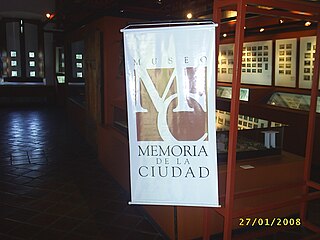
The Museum of the Memory of the City is located in the Viola House, one of the nine buildings that make up the architectonic complex Manzana de la Rivera, in front the Government house, in Asunción, capital of Paraguay. This Museum was an idea of the architect Carlos Colombino, and was inaugurated on 14 August 1996. a journey through its different spaces will allow to make a reading of Asuncion's history, in its different phases of development. The objects that it treasures had been collected in the country, as well as in the cities of New York City, Madrid, París, Montevideo and Buenos Aires.

San Carlos del Apa is a city of Paraguay in the Concepción Department, and a historical site located between River Apa and Stream Blandengues.

The history of yerba mate, that stretches back to pre-Columbian Paraguay, is marked by a rapid expansion in harvest and consumption in the Spanish South American colonies but also by its difficult domestication process, which even if discovered in the mid 17th century had to be rediscovered later when production was industrialized around 1900.
Below is a timeline of the history of Paraguay:

Tevego was a settlement and eventual penal colony in Paraguay between 1813 and 1823. It was repopulated in 1843, but then abandoned during the Paraguayan War in the 1860s. It was also known as Tebego, Etevego, Estevegó, Villa del Divino Salvador , or San Salvador.

The Payaguá people, also called Evueví and Evebe, were a ethnic group of the Guaycuru peoples in the Northern Chaco of Paraguay. The Payaguá were a river tribe, living, hunting, fishing, and raiding on the Paraguay River. The name Payaguá was given to them by the Guaraní, their enemies whom they nearly constantly fought. It is possible that the name of the Paraguay River, and thus the country Paraguay itself, comes from this; the Guaraní told the Spanish that the river was the "Payaguá-ý", or "river of Payaguás." The name they called themselves was probably Evueví, "people of the river" or "water people." The Payaguá were also known to early Spanish explorers as "Agaces" and spelling variations of that name.

Independence of Paraguayde facto started on May 14 of 1811 after the Revolution of May 14 when a local ruling junta was created. In early 1811 Paraguayan forces had repeatedly defeated the Argentinian army which considered Paraguay to be a break-away province. On October 12, 1813 the Paraguayan Republic was proclaimed. Officially Independence was proclaimed only on November 25, 1842. Paraguayan independence was assured only after the Paraguayan War, when the Empire of Brazil resisted Argentine offers to divide and annex the country.
